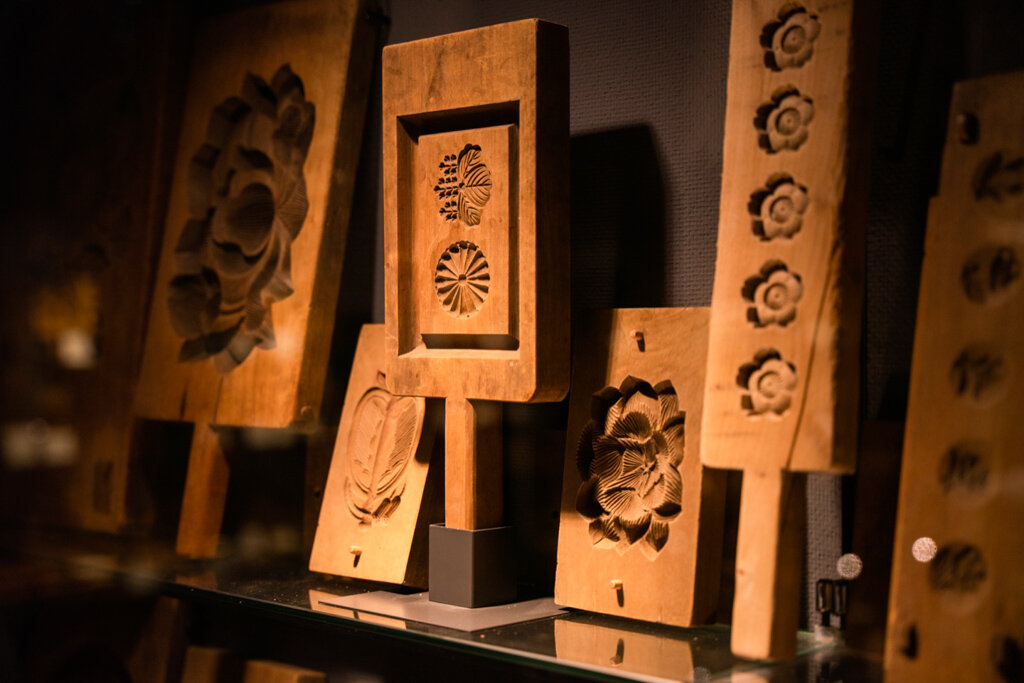The Legends and Literature Behind Wagashi
By Gabrielle Doman
Wagashi are traditional, lightly sweetened Japanese confections that have been continually developed and refined for over one thousand years. The first forms of wagashi were simple offerings of fruits and nuts made to Shinto deities and spirits, but are now typically made of mochi (pounded rice), sweet beans and agar-agar, and are eaten to celebrate seasonal changes or served during Zen Buddhist tea ceremonies to compliment the naturally bitter taste of matcha. There are many legends about the origin of many wagashi as well as various literary works that both recorded and inspired the use and creation of different wagashi.
Indeed, both the traditions of ritual drinking of tea and wagashi were introduced to Japan from China around the 9th century and evolved alongside each other. Therefore wagashi, like tea ceremony, is often wabi-sabi in style, with a simple aesthetic that invites one to appreciate simple pleasures. Ceremonial tea drinking first caught on with Japanese nobility after Emperor Saga (809-842) sampled sencha from China and promptly ordered tea to be cultivated domestically. While Japan’s tea culture was slowly being revolutionized, so too was wagashi, which had evolved into deep-fried rice and wheat flour, similar to sweets and offerings made in China.
But before the Chinese influenced the Japanese concept of wagashi, the idea of eating something sweet for luck and prosperity was already well entrenched in society, dating back to an ancient legend. Japan’s 8th ruler, Emperor Suinin (29 BC-70) is said to have fallen ill and instructed a courtier named Tajimamori (now the Japanese god of sweets) to find him a magical fruit that was purported to give immortality and eternal youth to those who ate it. The fruit is thought to have been tachibana, a citrus native to Japan and, though Tajimamori eventually found the fruit after a ten-year search, he was too late to save the emperor. As an offering, he planted the fruit beside the emperor’s tomb. From that point onwards, wagashi was associated with longevity and considered a fitting way to acknowledge important events and people.
Wagashi even has an annual celebration. The Day of Wagashi, held on 16th June, commemorates another Japanese emperor, Emperor Ninmyo (833-850). He is said to have offered 16 kinds of wagashi to the gods as a prayer for health and prosperity. The custom was popularized and wagashi became inextricably linked with good luck.
However, this kind of good luck offering wasn’t available to everyone. Due to the expense of some ingredients used, wagashi was also strongly associated with wealth, and many of the legends and stories around them depict nobility and abundance. The Tale of Genji (Genji Monogatari), written around 1021, is a perennially popular story about the lives and loves of the Japanese imperial court aristocracy. In the book, tsubakimochi (sweetened sticky rice flour wrapped in a camellia leaf) is served to the imperial court after a game of kemari, a group activity with no winners or losers in which a ball is passed from person to person by kicking it up in the air. This mention makes tsubakimochi the oldest documented wagashi, and one that is still popular today.
Each generation has further developed wagashi, moving it away from its Chinese origins and becoming indelibly linked to Japanese culture. Wagashi tells the story of Japan—its interactions with other cultures, its affinity for the changing seasons and its penchant for storytelling and legends. These culinary artworks embody Japanese aesthetics and cultural values.
The biggest changes to wagashi began during the Kamakura to Muromachi period (late 12th century to mid-16th century) when iterations of manjuu (steamed buns) and youkan (sweet red bean paste with agar-agar and sugar arranged in a block form) first emerged. But, surprisingly, it was during the Edo period (1603-1868), when Japan imposed a sakoku (locked country) policy that isolated it from most of the world, that much of the wagashi we recognize today was developed. Before Japan’s shutdown of foreign trade, sugar and egg-based sweets and cakes, such as castella, had been heartily welcomed into the country. This spurred the development of Japanese-produced egg and sugar-based wagashi, including konpeitou (sugar candy) and boro (egg biscuits).
The Edo period saw both wagashi and tea ceremonies become something new and distinctly Japanese. Nerikiri, an Edo period wagashi created by kneading and mixing sweetened white bean jam, Chinese yam, and glutinous rice flour, were colored and shaped to depict seasonal themes in Japan (think pink sakura for spring, icy tones for Japan’s hot summers and fiery maple leaves for fall). They were, and still are, considered an elegant delicacy, often served during tea ceremonies. When nerikiri was first introduced, sugar wasn’t accessible or affordable to most people, so nerikiri was reserved for special occasions. Other wagashi also began to take root in the local culture, with designs, names and shapes inspired by Japanese literature and mythology.
Kusamochi, for example, is one of Japan’s oldest wagashi. It is made by kneading mochi with mugwort leaves, which stems from a 9th-century tradition introduced to Japan from China, of eating mochi with herbs as a way to ward off evil spirits. This wagashi was popularized in the Edo period when it became customary to eat them for Hinamatsuri, Girls' Day, held annually on the 3rd of March. Practicality over taste was a common theme of some of the oldest wagashi. According to legend, chimaki, long, thin sticky rice dumplings wrapped in a bamboo leaf and tied with threads, are wrapped this way to ensure they can be given as offerings without evil spirits stealing them. Other tales suggest they were first wrapped by Uesugi Kenshin, one of the most powerful daimyō of the Sengoku period (1467-1615) as a way to preserve food and make it portable to take to battle.
Many wagashi have more poetic roots. Monaka, for example, comes from an Edo-era sweet called monaka no tsuki (moon in the middle of autumn) that was once sold at a rice cracker shop in Tokyo. These wagashi were said to resemble the moon reflected on a pond. Nowadays, monaka is made from rice wafer molds filled with bean paste or ice cream. The snack was purportedly named after a waka (classical Japanese poem) by Minamoto no Shitagou, a mid-Heian era poet, which can be translated to “Many days had passed as gazing at the moon reflected in the shimmering surface of the pond. Ah… It feels like the season is deepening. This night, I’m in the middle of autumn…”
Matsuo Basho (1644-1694), Japan’s most famous haiku poet, was directly inspired by aozashi, a confection made from ground and fried green barley twisted into a thread. His haiku about the ancient snack translates to:
aozashi ya
kusa mochi no ho ni
ide tsuran
Green grain crackers,
the wheat ears come out of
veggie cookies (1683)
In turn, Matsuo Basho inspired the creativity of wagashi artisans. Following his recitation of a haiku about cherry blossoms during a visit to Iga in Mie prefecture, the local wagashi shop, Koubaiya, produced samazama-zakura, melt-in-the-mouth wagashi that resembles blossom-shaped confetti.
samazama no
koto omoidasu
sakura kana
How many, many things
they call to mind,
These cherry blossoms! (1688)
Wagashi has a long history of finding muses in Japanese creatives. The origins of yatsuhashi, made from steamed rice flour, sugar and cinnamon that has been stretched thin, are thought to have been created in memory of an Edo-era blind monk called Yatsuhashi Kengyo, credited for inventing the koto (a traditional string instrument). Kengyo was an advocate for reducing waste and was known for turning leftover rice into crackers. After his death, legend has it that his village honored his memory by creating a rice sweet that curved like a koto. An alternate theory behind yatsuhashi is that it is named after a scene in The Tales of Ise, a Heian period (794-1185) story which is the first to depict a yatsuhashi (meaning eight bridges), the name given to a Japanese walking bridge made of zigzagging planks of wood. Wherever the inspiration came from, yatsuhashi has its roots in the Japanese arts. It remains immensely popular today, particularly among tourists to Kyoto, where it is among the most purchased omiyage (souvenirs).
Much of the wagashi we eat today can be traced back to artisans and nobility, but minazuki was invented by poorer families. Minazuki, a steamed rice flour cake topped with a layer of red beans, is traditionally eaten in Kyoto on June 30th on a day known as Nagoshi no Harae, The Purification Ritual of Summer’s Passing. On this day, members of the imperial court would snack on ice. Those poorer families without access to ice would make minazuki. This wagashi is said to cool you down, clear away mid-year chaos, attract blessings and drive away evil spirits.
These uniquely Japanese wagashi were painstakingly compiled in picture books to meticulously record the designs and names of wagashi to ensure they can be kept consistent over the years. Onmushigashizu is the most famous of these wagashi encyclopedias, resembling a beautiful book of poems more than a compilation of recipes. The most prestigious and historic wagashi shops still make each piece according to these traditional specifications.
However, this ever-evolving art always maintains reflections of the current culture. Neo-wagashi is this generation’s update on Japanese confectionery. It features Western additions, such as whipped cream and chocolate, and can be served with wine. Presentation is key, and modern wagashi artisans are exploring plating methods more commonly seen in Michelin-starred restaurants—including spun sugar lattice flourishes, piped cream, edible flowers and abstract design. The concept is to respect the traditions and nostalgia of wagashi but update them for the 21st century.
But, even as they evolve, wagashi artisans retain the confection’s traditions, depicting Japan’s cultural and artistic evolution. From the ancient legends of Emperor Suinin and Tajimamori, to references found in classic works like The Tale of Genji and the poetic imagery in Matsuo Basho’s haiku, wagashi reflect Japan’s deep connection to its history and aesthetics, celebrating its cultural heritage in each bite.
About the Author: Gabrielle Doman is a British writer based in Tokyo. She has worked on newspapers and magazines in the UK, UAE, Cambodia, Thailand, the Netherlands and Japan on titles including The Independent, Gulf News, Louis Vuitton Guides and Harpers Bazaar. You can read more of her work here https://gabrielledoman.journoportfolio.com/








